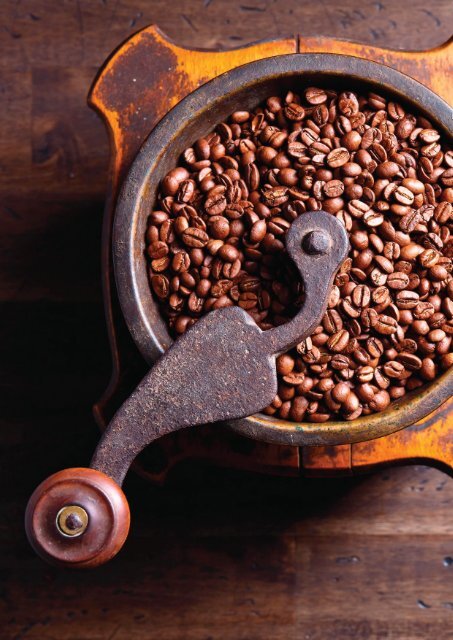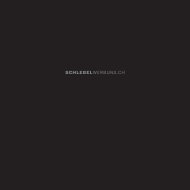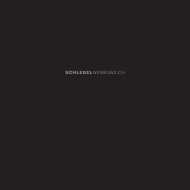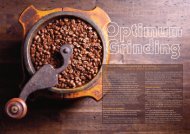Optimum Grinding May 2018
You also want an ePaper? Increase the reach of your titles
YUMPU automatically turns print PDFs into web optimized ePapers that Google loves.
Thomas Holzinger, Holzinger Consulting, discusses cement<br />
grinding system optimisation.<br />
Introduction<br />
The cement industry uses a wide range of different<br />
systems in raw material, coal, and cement<br />
grinding. While new plants mainly focus on highly<br />
energy‐efficient systems, using roller comminution<br />
systems like vertical roller mills (VRMs) and high<br />
pressure grinding units (roller presses), less efficient<br />
ball mills and combined grinding systems (pre-grinder<br />
plus ball mill) are still widely used. Which option to<br />
install depends on the local cement market, the product<br />
portfolio and raw materials, as well as the relevant<br />
operational skills available to maintain such systems.<br />
The industry is facing high volumes in every global<br />
market and cement pricing is driving producers to<br />
optimise their systems to peak performance. Rising<br />
electrical energy costs have created a trend to force<br />
plants to reduce their production costs by system and<br />
wear part strategy optimisation.<br />
Raw material grinding<br />
The current standard solution for raw material grinding<br />
is the VRM, offering the advantages of an efficient<br />
comminution system combined with a high drying<br />
capacity.<br />
From the mineralogical and ‘burnability’ of raw<br />
meals, roller presses in finish-grinding mode should be<br />
considered as an alternative to VRMs. A prerequisite is<br />
that the raw mix moisture content should be below 8%<br />
and the clay content less than 6%. Due to better wear<br />
protection solutions for highly abrasive materials, roller<br />
presses are a viable alternative to VRMs.<br />
Ball mills meanwhile, due to low electrical energy<br />
efficiency and limitations on drying capacity, play a<br />
minor role in new installations.<br />
Cement grinding<br />
In Table 1, three common cement grinding systems are<br />
compared on their electrical consumption for a typical<br />
3500 Blaine ordinary portland cement (OPC).<br />
Roller press finish-grinding systems, due to lower<br />
fan power demand compared to a VRM, exhibit a lower<br />
specific energy consumption.<br />
The only restriction of such a system is the maximum<br />
roller size of 2.2 m with an installed motor power of<br />
3400 kW, which is 2380 kW absorbable power, limiting<br />
production of a 3600 Blaine OPC cement to around<br />
140 tph.<br />
For the cement quality of a roller press<br />
finish‐grinding system, studies show that for a<br />
standard type cement compared to VRM or ball mill,<br />
no differences could be observed. Only for fine cement<br />
types (>4500 Blaine), requiring high early strengths, did<br />
the roller press finish-grinding system achieve slightly<br />
lower strength performances.
Table 1. Comparison of cement grinding systems for ordinary portland cement at 3500 Blaine, 4% limestone.<br />
Ball mill Combi grinding system Finish grinding<br />
Ball mill with cage<br />
rotor separator<br />
Roller press in semi-finish<br />
mode and ball mill<br />
Spec.el Energy consumption mill motors kWh/t 30 25 17 17<br />
% at mill motor (ball mill 100%) % 100 83 57 57<br />
Spec.el. Energy consumption mill system kWh/t 39 32 27 26<br />
% department (ball mill 100%) % 100 82 69 67<br />
VRM<br />
Roller<br />
press<br />
Optimisation of grinding systems<br />
To optimise grinding systems, it is important to<br />
understand the processes and what the equipment was<br />
originally designed for. Figure 1 shows the processes<br />
in the various systems. The following process steps are<br />
taking place in the system:<br />
Figure 1. Shows a typical flowsheet for a ball mill<br />
installation.<br />
Drying Coarse <strong>Grinding</strong> Fine <strong>Grinding</strong> Classification<br />
Ball Charge<br />
Management<br />
<strong>Grinding</strong><br />
Ventilation and Cooling<br />
Operation and Control<br />
Figure 0: Production Process Chain<br />
Figure 2. Ball mill production process chain.<br />
1. Drying.<br />
2. Coarse grinding.<br />
3. Fine grinding.<br />
4. Cooling and mill ventilation.<br />
5. Classification.<br />
6. Mill operation and control.<br />
To optimise a system, it must be considered that<br />
all these processes are interlinked and connected in a<br />
process chain, meaning that, focusing simply on one<br />
process, will not immediately achieve success. There is a<br />
production chain to be considered shown in Figure 2.<br />
A typical process starting point to analyse a system<br />
for its efficiency is to carry out an audit, a ‘health check’<br />
of the grinding system. A regular audit, performed at<br />
a minimum once a year, consists of the following two<br />
phases:<br />
1. A system check of the running condition.<br />
2. An equipment and system check in a stopped<br />
condition.<br />
If everything is well prepared by all the involved<br />
departments (e.g. maintenance, quality, process,<br />
production) one or two days should be enough for all<br />
the activities.<br />
It is crucial that the product is not changed during<br />
the audit and the mill must be stable during circuit<br />
sampling and performance data collection for at least<br />
6 − 8 hours. Circuit stability means stable material flow<br />
(fresh feed and classifier rejects).<br />
In running condition, material sampling (fresh feed,<br />
circuit samples, finished product), airflow measurements<br />
and, data recording are taking place (e.g. production<br />
rate, cement type and composition, fineness, energy<br />
consumption of mill motor etc). This data will later be<br />
evaluated and documented in terms of the following:<br />
Figure 3. Worn out and deformed media from the<br />
second chamber.<br />
• l Specific electrical energy of mill motor system.<br />
• l Circulating load and classification of efficiency.<br />
• l Dew point, critical temperature, and pressure.<br />
Reprinted from <strong>May</strong> <strong>2018</strong><br />
World Cement
During mill stopped condition, it is important to:<br />
• l Evaluate the grinding performance in both<br />
chambers along the mill.<br />
• l Examine the grinding tools (liner and media), check<br />
their filling level, and state in terms of wear and<br />
deformation.<br />
If balls and liners are not in good condition, the mill<br />
suffers from efficiency loss, meaning electrical energy<br />
consumption and production costs will increase.<br />
As an example of a trial on the influence of<br />
grinding media shape on mill performance, a twin<br />
grinding system is illustrated, which is identical in<br />
terms of installation, maintenance, and cement<br />
production.<br />
The only difference is that one mill got a completely<br />
new ball charge in the second chamber, while the other<br />
mill was left with used deformed balls in the same<br />
general size composition (Figure 3).<br />
Running both systems to their limits, the result<br />
was a clear difference in specific electrical energy<br />
consumption (SEEC) of about 5 kWh/t on mill motor<br />
power consumption at a mill motor total SEEC of<br />
30 kWh/t. This results in a loss of 16%, simply due to<br />
completely deformed second chamber media.<br />
In many site visits observed by the author, although<br />
plant operators have carried out ball sorting, mainly<br />
only ball classification was carried out.<br />
Similar to the ball charge quality, the liner shape<br />
and condition has a major influence on mill efficiency,<br />
especially for the first chamber when the feed material<br />
is coarse (>30 mm) and hard to grind.<br />
Besides grinding tool management and its process<br />
importance, the following checks are typically carried<br />
out.<br />
Cooling and drying limitations<br />
A simple heat balance indicates the limitations, is useful<br />
for the introduction of new products, and is used to<br />
highlight the limitations of the system in the event of a<br />
moisture increase of the feed material mix.<br />
Mill ventilation<br />
Besides limiting both the cooling or drying of the<br />
system, an under-ventilated mill (
Figure 4. Flowsheet of a combined grinding system with<br />
roller press.<br />
Figure 0: Typical Vertical Roller Mill Flowsheet for Cement <strong>Grinding</strong><br />
Figure 5. Typical VRM flowsheet for cement grinding.<br />
Figure 6. Production process chain for a VRM.<br />
There are existing systems where no finished<br />
product is produced on the roller press classifier, but<br />
sent directly as feed material to the ball mill. These<br />
systems create good opportunities to increase system<br />
performance by modification. A completely new<br />
installation would use a short, one chamber mill<br />
(L/D 2.5, are commonly too long and have too<br />
much power available. Therefore, it is necessary to<br />
evaluate the modifications of the mill internals, ball<br />
charge composition, and filling level.<br />
A major drawback of performance losses in such<br />
systems, is an inadequately working pre-grinder, where<br />
the wear strategy and used roller materials are not<br />
aligned. Having the ball mill adjusted for a certain feed<br />
size, the pre-grinder must provide a generally constant<br />
supply, considering that adapting the ball charge<br />
composition is not easily done without extra stoppage<br />
time and expense.<br />
Finish grinding: VRM system<br />
For raw material, as well as for fuel grinding, this is<br />
the most commonly used system.<br />
For cement grinding, it is a very efficient<br />
system, which is currently widely installed. Due<br />
to the development of various multi-motor drive<br />
solutions by all major suppliers, big installations of<br />
up to 12 000 kW or more can be realised, achieving<br />
the highest production rates for a single grinding<br />
system.<br />
In addition to the distinct advantages of such<br />
a system (including low specific electrical energy<br />
consumption, easy operation, and high drying/cooling<br />
capacity) there are also some disadvantages which<br />
have to be considered. Spare part costs are high, even<br />
when maintenance costs are lower than for ball mills,<br />
due to the fact that as a must, a separate reducer and<br />
one spare roller should be stocked onsite. The main<br />
reason for VRM stoppages is still mill vibration. When<br />
having gearboxes >3 MW installed, it is recommended<br />
to use gearbox protection systems, monitoring<br />
vibrations in the gearbox, to be alert to developing<br />
problems before critical damage occurs.<br />
Figure 5 explains the processes in a VRM where<br />
there is optimisation potential and corrective<br />
measures can be performed.<br />
Besides mechanical issues with the reclaimer, feed<br />
bins, and elevator, which may cause several stoppages<br />
,significantly influencing system performance, the<br />
feed size of the material is also of great importance.<br />
As a rule, for VRMs, the feed material should always<br />
be
maximum of around 2.5% of production rate and to keep<br />
the dew point at less than 55°C. Higher values will lead to<br />
reduced early strength of the final cement product.<br />
It is of vital importance to have a stable and<br />
homogeneous mill feed particle size distribution<br />
for stable and optimal operation. The mill and its<br />
mechanical setup cannot easily handle any short-term<br />
variations in feed size, e.g. mill table dam-ring height,<br />
accumulator pressure or table speed, leading directly to<br />
mill stability problems and performance loss.<br />
In raw material grinding, the drying capacity can be<br />
a limitation, leading to reduced mill production, which<br />
might be a limitation for the kiln and hence for clinker<br />
production.<br />
The drying capacity can also be caused by a high<br />
false air intake, which most mills suffer from. High false<br />
air also means high fan power consumption, which<br />
can limit the production rate. It increases the electrical<br />
energy consumption of the mill fan leading to higher<br />
plant production costs.<br />
Conclusion<br />
The airflow inside a VRM is of significant importance<br />
to internal mill material transportation. A correct air<br />
velocity profile must be respected. The upward velocity<br />
throughout the mill height must always increase.<br />
Decreasing velocity could be due to incorrect mill<br />
internal design. Decreasing air velocity inside the mill<br />
body has the effect of increased internal material<br />
recirculation, causing an increased mill pressure drop,<br />
leading to reduced feed rates and high energy demand<br />
in the system.<br />
For VRM systems, it is highly recommended to use<br />
automated mill control systems, considering all relevant<br />
parameters to guarantee maximised operation close to<br />
system limitations. For an operator, it is very difficult to<br />
follow all changing parameters on top of other tasks<br />
to be carried out during a shift.<br />
Optimising such systems and running them to the edge<br />
of performance is a complex task. All departments must<br />
work closely together and understand what is relevant for<br />
good and stable operation of grinding systems.<br />
Optimisation of grinding systems is not only the task<br />
of process operators but also of the plant management<br />
and its understanding of each department’s<br />
requirements and how departments work together.<br />
About the author<br />
Thomas Holzinger has a Masters Degree from Leoben<br />
University, Austria, in Mining, Metallurgy & Materials. In his<br />
20 years’ experience in the fine grinding of minerals, he<br />
has worked for leading companies in corporate functions<br />
as a milling and classification expert and consultant. As a<br />
Lead Consultant for LafargeHolcim, he was mainly involved<br />
in plant design and performance analyses of plants and<br />
grinding systems throughout the world.<br />
Reprinted from <strong>May</strong> <strong>2018</strong><br />
World Cement









